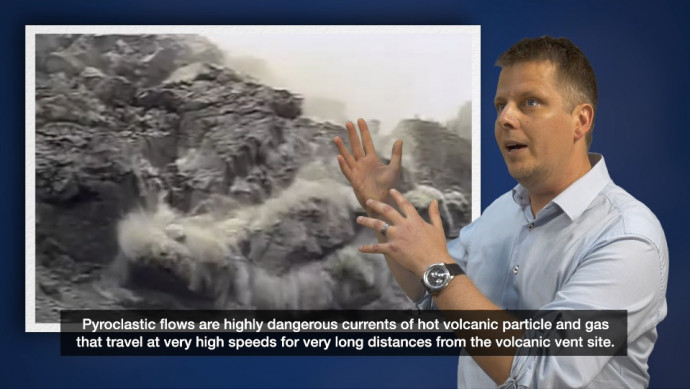Driving force of volcanic super-hazards uncovered

Posted 11 April 2019
Massey volcanologists have discovered the driving force behind superheated gas-and-ash clouds from volcanic eruptions, which may help save lives and infrastructure around the globe.
Source: Massey University media release
Endangering 500 million people worldwide, pyroclastic density currents (or pyroclastic flows) are the most common and lethal volcanic threat, causing 50 per cent of fatalities caused by volcanic activity. During volcanic events, these currents transport hot mixtures of volcanic particles and gas over tens of kilometres, causing damage to infrastructure and loss of life.
One of the issues to studying these phenomena is that they are impossible to measure in real life. Using Massey’s Pyroclastic flow Eruption Large-scale Experiment (PELE) eruption simulator facility, the team were able to synthesize the natural behaviour of volcanic super-hazards and generate these flows as they occur in nature, but on a smaller scale.
Until now, scientists could not find the mechanism responsible for the super-mobility of these flows, and previous models were unable to accurately predict their velocity, runout and spread through hazard models, which put lives and infrastructure at risk.
Massey University’s Associate Professor Gert Lube says that through their unique experiments, the enigmatic friction-cheating mechanism was found.
“With several tonnes of pumice and gas in motion, our large-scale eruption simulations uncovered the flow enigma that has been baffling researchers for decades. We measured a low-friction air cushion that is self-generated in these flows and perpetuates their motion. We were able to mathematically describe the resulting flow behavior. There is an internal process that counters granular friction, where air lubrication develops under high basal shear when air is locally forced downwards by reversed pressure gradients and displaces particles upward.
“This explains how the currents are able to propagate over slopes, bypass tortuous flow paths, and ignore rough substrates and flat and upsloping terrain, without slowing down.”
“The discovery necessitates a re-evaluation of global hazard mitigation strategies and models that aim to predict the velocity, runout and spreading of these flows. Discovery of this air-lubrication mechanism opens a new path towards reliable predictions of pyroclastic flow motion and the extreme runout potential of these lethal currents, thereby reducing future casualties. It will be used by hazard scientists, as well as decision makers, and is envisaged to lead to major revisions of volcanic hazard forecasts.”
The article, Generation of air lubrication within pyroclastic density currents, was published in Nature Geoscience.
Authors include Massey’s Professor Jim Jones, Dr Luke Fullard, Eric Breard and Joseph Dufek of the University of Oregon, Shane Cronin of University of Auckland and Ting Wang of the University of Otago. Funding includes Royal Society Te Apārangi Marsden Fund and the Ministry of Business, Innovation and Employment's Endeavour Fund.
These findings have been widely covered:
Stuff.co.nz: Secret to deadly, fast-moving volcanic flows unlocked by NZ scientists
Scientific American: Deadly Volcanic Flows Glide on Their Own Cushion of Air
The Guardian: 'Hovercraft effect' may explain deadly speed of volcanic gas clouds
National Geographic: Volcanic 'avalanches' glide on air, boosting their deadly speed
Science News: How deadly, fast-moving flows of volcanic rock and gas cheat friction
PBS Nova: Volcanoes’ Deadly Pyroclastic Flows Surf on Air to Achieve Super Speed
This research was supported by Marsden Fund contract MAU1506 'Super-volcanic flows: are they just all hot air?'
